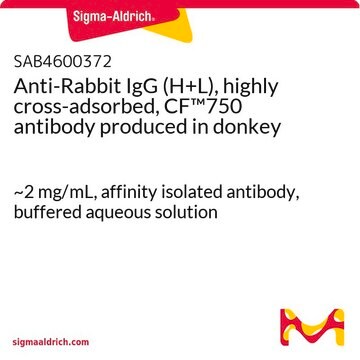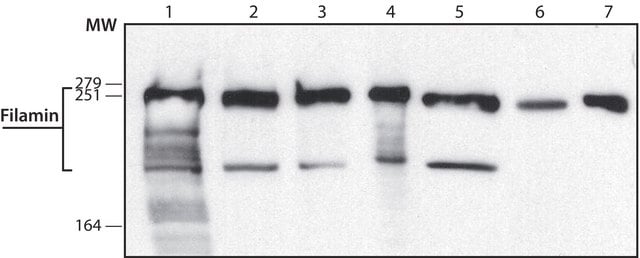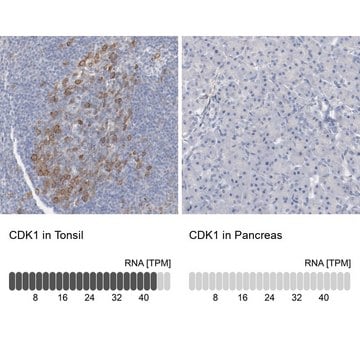SAB4200861
Anti-PSTAIR antibody, Mouse monoclonal
clone PSTAIR, purified from hybridoma cell culture
Sinônimo(s):
pan-CDKs
Faça loginpara ver os preços organizacionais e de contrato
About This Item
Código UNSPSC:
12352203
NACRES:
NA.41
Produtos recomendados
forma do anticorpo
purified from hybridoma cell culture
Nível de qualidade
clone
PSTAIR
forma
liquid
reatividade de espécies
rat, monkey, human, mouse
concentração
~1 mg/mL
técnica(s)
immunoblotting: 0.5-1.0 μg/mL using whole extracts of COS7 cells.
Isotipo
IgG1
Condições de expedição
dry ice
temperatura de armazenamento
−20°C
modificação pós-traducional do alvo
unmodified
Descrição geral
Cell division is a fundamental biological process, consisting of the splitting of the cell and its genetic material into two daughter cells. Mitosis is a cell division process that results in the formation of two new nuclei, each having the same number of chromosomes as the parental nucleus. During the cell cycle of most somatic cells, DNA synthesis (S-phase) and mitosis (M-phase) are separated by two "growth" stages (G1 and G2) of varying duration. A typical eukaryotic cell sequentially passes through G1, S, G 2, and M and back into G1 during each single cycle.9 Maturation-promoting factor (MPF), originally identified during meiosis in frog oocytes, is a cytoplasmic factor, which is highly conserved among a wide range of species. Itplays a key role in the progression of the cell cycle from interphase (G2) to metaphase (M), in both meiosis and mitosis.
Especificidade
Monoclonal Anti-PSTAIR antibody specifically recognizes the evolutionary conserved PSTAIR sequence. The antibody recognizes 31-34 kDa proteins (1-4 bands) in immunoblotting.1-7 Cross-reactivity has been observed with human, monkey, mouse,1,8 Japanese quail,1,3 fish (goldfish,4-7 carp,1,5,7 eel,1 starfish,1 and amago salmon1 ), Xenopus,1 cliliates,1 and plants (lily,1,2 and onion1 ).
Aplicação
The antibody may be used for Immunoblotting based assays.
Ações bioquímicas/fisiológicas
The cell cycle can be considered as a cyclin-dependent kinases (cDKs) cycle, which is controlled by biochemical modifications such as phosphorylation of CDKs and formation of complex(es) with other proteins, including the cyclins.10 CDKs are key regulators of cell cycle progression.11,12 and are closely related in size (35-40 kDa) and sequence (>40% identity). Each CDK interacts with a specific subset of cyclins which activate them by enabling their phosphorylation at specific residues.
In the fission yeast Shizosaccharomyces pombe, a single major CDK has been identified (cdc2) while in human cells, the growing list of CDKs now includes also cdc2 (Cdk1), and Cdk2 to Cdk7. The typical CDK catalytic subunit contains a 300 amino acid catalytic core that is completely inactive in monomeric and unphosphorylated state.13 15.14 CDKs are constitutively expressed throughout the cell cycle and are activated and inactivated by specific kinases and phosphatases.15,16 In every eukaryote examined, CDKs contain an evolutionary conserved 16 amino acid sequence called PSTAIR (EGVPSTAIREISLLKE) which distinguishes them from other protein kinases. The PSTAIR motif is involved in the complex formation with cyclins. The availability of monoclonal antibody reacting specifically with the PSTAIR sequence1,17 enables the subcellular detection and localization of the various CDKs and examination of substrate interactions, in a variety of organisms.
In the fission yeast Shizosaccharomyces pombe, a single major CDK has been identified (cdc2) while in human cells, the growing list of CDKs now includes also cdc2 (Cdk1), and Cdk2 to Cdk7. The typical CDK catalytic subunit contains a 300 amino acid catalytic core that is completely inactive in monomeric and unphosphorylated state.13 15.14 CDKs are constitutively expressed throughout the cell cycle and are activated and inactivated by specific kinases and phosphatases.15,16 In every eukaryote examined, CDKs contain an evolutionary conserved 16 amino acid sequence called PSTAIR (EGVPSTAIREISLLKE) which distinguishes them from other protein kinases. The PSTAIR motif is involved in the complex formation with cyclins. The availability of monoclonal antibody reacting specifically with the PSTAIR sequence1,17 enables the subcellular detection and localization of the various CDKs and examination of substrate interactions, in a variety of organisms.
forma física
Supplied as a solution in 0.01 M phosphate buffered saline pH 7.4, containing 15 mM sodium azide as a preservative.
Armazenamento e estabilidade
For continuous use, store at 2-8°C for up to one month. For extended storage, freeze in working aliquots. Repeated freezing and thawing is not recommended. If slight turbidity occurs upon prolonged storage, clarify the solution by centrifugation before use. Working dilution samples should be discarded if not used within 12 hours.
Exoneração de responsabilidade
Unless otherwise stated in our catalog our products are intended for research use only and are not to be used for any other purpose, which includes but is not limited to, unauthorized commercial uses, in vitro diagnostic uses, ex vivo or in vivo therapeutic uses or any type of consumption or application to humans or animals.
Código de classe de armazenamento
12 - Non Combustible Liquids
Classe de risco de água (WGK)
WGK 1
Ponto de fulgor (°F)
Not applicable
Ponto de fulgor (°C)
Not applicable
Certificados de análise (COA)
Busque Certificados de análise (COA) digitando o Número do Lote do produto. Os números de lote e remessa podem ser encontrados no rótulo de um produto após a palavra “Lot” ou “Batch”.
Já possui este produto?
Encontre a documentação dos produtos que você adquiriu recentemente na biblioteca de documentos.
Nossa equipe de cientistas tem experiência em todas as áreas de pesquisa, incluindo Life Sciences, ciência de materiais, síntese química, cromatografia, química analítica e muitas outras.
Entre em contato com a assistência técnica








